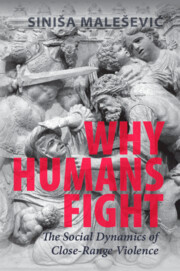Human history is often narrated as a story of fighting. The earliest written records including engravings in clay tokens, limestone tablets, ancient monuments, and antique documents contain extensive descriptions of human belligerence. For example, one of the early etchings found in the ruins of ancient Near East settlements and attributed to Ashurnasirpal II, king of Assyria from 884 to 859 bce, is completely centred on the experience of fighting and killing. The inscription depicts Ashurnasirpal’s first military campaign that involved quashing an armed rebellion in the city of Suru in 883 bce. This record provides a detailed depiction of close-range human-on-human violence:
I flayed all the chiefs who had revolted, and I covered the pillar with their skins. Some I impaled upon the pillar on stakes and others I bound to stakes round the pillar. I cut the limbs off the officers who had rebelled. Many captives I burned with fire and many I took as living captives. From some I cut off their noses, their ears, and their fingers, of many I put out their eyes. I made one pillar of the living and another of heads and I bound their heads to tree trunks round about the city. Their young men and maidens I consumed with fire. The rest of their warriors I consumed with thirst in the desert of the Euphrates.
(Finegan 2015: 170–1)Other ancient and early modern written accounts also contain numerous descriptions of close-range fighting including wars, rebellions, uprisings, insurgencies, assassinations, acts of rioting and massacres of civilians (Bestock 2018; Classen 2004; D’Huys 1987). Similarly, the history textbooks published over the last three centuries are full of extensive depictions of violent conflicts where soldiers, police officers, revolutionaries, rebels, insurgents, terrorists, protesters, paramilitaries, and ordinary individuals fight and kill other human beings (Bentrovato et al. 2016; Ferro 2004). The military scholarship from Thucydides, Machiavelli, and Clausewitz to the contemporary neo-realism of Waltz and Mearsheimer has identified fighting as a crucial element of social and political order. As Clausewitz (2008 [1832]: 227) emphasises: ‘Fighting is the central military act; all other activities merely support it. Its nature consequently needs close examination. Engagements mean fighting. The object of fighting is the destruction or defeat of the enemy.’


